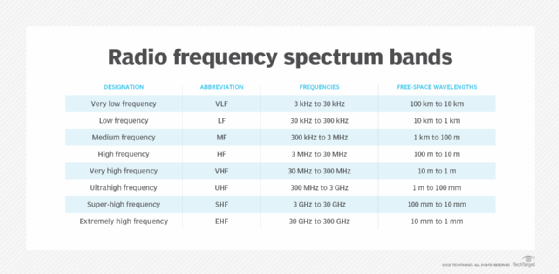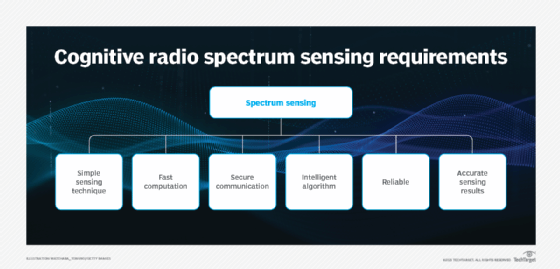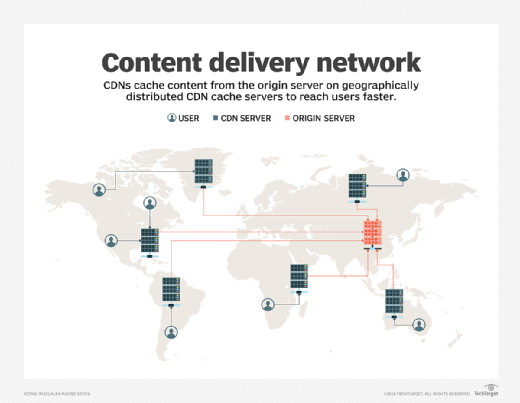cognitive radio (CR)
Cognitive radio (CR) is a form of wireless communication in which a transceiver can intelligently detect which communication channels are in use and which ones are not. The transceiver then instantly moves into vacant channels, while avoiding occupied ones. These capabilities help optimize the use of the available radio frequency (RF) spectrum.
It also minimizes interference to other users. And, by avoiding occupied channels, it increases spectrum efficiency and improves the quality of service (QoS) for users.
The wireless RF spectrum is a limited resource, usually allocated through a licensing process. In the U.S., it is the joint responsibility of the Federal Communications Commission (FCC) and the National Telecommunications and Information Administration (NTIA). The FCC administers the spectrum for non-federal (e.g., commercial) use, while the NTIA does the same for federal (e.g., military, FBI) use.
The allocated (licensed) spectrum is not always used optimally. As a result, some bands are overcrowded (e.g., GSM cellular networks), while others are relatively unused (e.g., military). This spectrum inefficiency limits the amount of data that can be transmitted to users and lowers service quality.
As the number of connected devices in use continues to grow, this limited resource is fast becoming a scarce resource. Cognitive radio is an efficient way to use and share this resource intelligently, optimally and fairly.

Cognitive radio networks and capabilities
Joseph Mitola at the KTH Royal Institute of Technology in Stockholm, first proposed the idea of cognitive radio in 1998. It is a hybrid technology involving software-defined radio (SDR) as applied to Spread spectrum communications.
A cognitive radio network (CRN) is split into two main networks, a primary network and a secondary network. The primary network owns the licensed band and consists of the primary radio base station and users. The secondary network shares the unused spectrum with the primary network. It consists of the cognitive radio base station and users.
The three key capabilities that differentiate cognitive radio from traditional radio are:
- Cognition: CR understands its geographical and operational environment.
- Reconfiguration: According to this cognitive knowledge, CR can decide to dynamically and autonomously adjust its parameters.
- Learning: CR can also learn from the experience, and experiment with new configurations in new situations.
Cognitive radio facets
The two main facets used in CR are spectrum sensing and spectrum database.
Spectrum Sensing
CR devices track the spectrum bands in their neighborhoods to identify users licensed to operate in that band. They also look for unused portions of the RF spectrum known as white spaces or spectrum holes. These holes are created and removed dynamically and can be used without a license.
Spectrum sensing may be cooperative or non-cooperative. In the cooperative method, cognitive radio devices share spectrum information, while in the non-cooperative method, each CR device acts on its own.

Spectrum database
TV stations update their next week’s use of the RF spectrum in a database that the FCC maintains. Cognitive radio devices can seek information about free spectrum from this database, so they don’t have to rely on complex, time-consuming and expensive spectrum sensing techniques.
The drawback of this method is it’s difficult for the database to update dynamic spectrum activity in real time. As a result, CR devices may miss out on opportunities to access unused spectrum.
To support the growing number of devices that use the RF spectrum, a combined approach is useful. It ensures that devices can quickly and accurately detect unused spectrum and so improve QoS.
Types of cognitive radio
The two main types of CR are heterogeneous and spectrum-sharing.
In heterogeneous CR, operators run several radio access networks (RANs) using the same or different radio access technology (RAT) protocols. Heterogeneous cognitive radio uses a network-centric approach, and the frequency bands allocated to the various RANs are fixed.
In spectrum-sharing CR, several RANs share the same frequency band. They also coordinate with each other to use unoccupied sub-bands intelligently and optimally.
In both CR types, radio resources are optimized, and the QoS is much better than it would be with traditional radio.
Another way of categorizing CR is as full cognitive or spectrum sensing. Full cognitive CR takes into account all parameters that a wireless node or network can be aware of. Spectrum-sensing CR detects channels in the RF spectrum.
Applications of cognitive radio
CR is a disruptive new technology with many potential applications. This is why it is also known as a next-generation communication network.
For example, CR can help address connectivity problems in rural areas. It can also optimize RF operations for smartphones and IoT devices, content delivery networks, also known as content distribution networks, and giant wireless hotspots.

Other potential applications include:
- City- and campus-wide network RF coverage
- Leased networks
- Disaster relief
- Emergency networks
- Cognitive mesh networks
- Medical applications
- Weather forecasting
- Traffic control
According to the IEEE, cognitive radio may even be used in space communications, particularly far outside of Earth's orbit.







